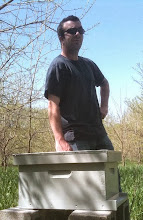Honeybees are synonymous with tireless industry, and with good reason. The chores in a hive are many, and bees seem to learn these without being told what needs to be done, or even how to go about it.
Once a honeybee has been born and crawls out of her cell, she becomes a productive member of her community, instinctively knowing that she is expected to do her share of the work required of each for the benefit of the whole.
Here's a general overview of hive chores as determined by the age of the workers:
- Cell cleaning: Honeybees are incredibly compulsive about sanitation. Empty cells are thoroughly cleaned before they are deemed worthy of receiving either food or brood. A productive hive's queen can lay up to 1,500 eggs a day, and since cells are reused, they must be cleaned before a new egg can be deposited. If, in the course of her egg laying activity, a queen finds a cell that has not been cleaned to her satisfaction, she will skip it and move to a cleaner one. Workers will clean and polish the cells until they are about 3 days old.
- Feeding larvae: After hatching, all larvae are fed royal jelly for about three days. Royal jelly is created by the workers themselves - secreted from a gland in their heads - and is comprised primarily of water, simple sugars, proteins, and fatty acids, with trace amounts of antibiotic and antibacterial components. After these three days, the larvae will no longer be fed royal jelly; their diet is switched to pollen, nectar or diluted honey. Queen larvae, however, will be fed royal jelly exclusively until she pupates and emerges from her cell. Workers aged 3 to 7 days are responsible for feeding the older larvae, while those 7 to 14 days old will secrete royal jelly and feed the younger brood and developing queens, if any.
- Comb building: The structure on which honeybees' entire lives are spent is a network of hexagonal wax cells. These cells are used to store food and to raise young: honey and pollen are stored in some of these cells, and eggs are laid in others. (While many animals will construct shelters made from materials that they find and collect, honeybees are the only ones known to build their homes from substances produced solely by their own bodies.) The wax is secreted from glands on the underside of workers' abdomens, then chewed until soft and pressed into place on the comb. Workers aged 7 to 14 days are at the peak of their wax production. Additionally, if a bee should die within the hive, its body is dragged out and dropped off the edge of the landing board. Diseases can spread rapidly, and bees understand that one instance of illness can mean the death of the entire colony. The undertaker duties are... undertaken... by workers in this same age group.
- Defense: At around 14 days of age, honeybees begin to become curious about the world beyond the confines of the hive. They will take their first steps outside the entrance and onto the landing board, where they can observe their older sisters coming and going. They become the hive guards, taking position near the entrance to ensure that any foragers attempting to gain access are authorized to do so -- their scent must be recognizable. An invader, such as a predatory hornet or a bee from another hive with designs on their honey, will be dealt with quickly and lethally, though sometimes the guards will allow an unknown honeybee to enter, if she bribes them with a bit of nectar.
- Foraging: At about 21 days old, workers have graduated from house duties to fieldwork. These new foragers will take their first orientation flights, guided by those with more experience. Once familiar with the location of the hive and its immediate surroundings, they will search for flowers to visit, and will collect pollen, primarily. Having gained some experience, the foragers will collect nectar. These older bees will forage until they die. It's not uncommon to notice bees with tattered wings within a colony. These are the oldest of the workers, and may have flown up to 500 miles during their foraging flights over the course of their lifetime.

Other tasks include honey production, temperature control, and water collection. These do not fall to workers of a specific age (although it can be assumed that water collection must by necessity be carried out by foragers who know their way to and from the hive), but are shared by all the bees in a colony. Honey production and temperature control are similar tasks: the water must be evaporated from stored nectar in order for it to be transformed into honey. This involves many bees rapidly beating their wings while standing in place, to fan the nectar and allow it to thicken and ripen. Likewise, when the temperature is hot, some bees will collect water and moisten the comb, and this same fanning will cool the interior of the hive through evaporative cooling.
There is some overlapping of the age ranges engaged in these various duties. If, as can happen under certain circumstances, the age groups are not in normal balance, bees of any age can do the work necessary, though with less efficiency. Field bees and those under 3 days old can feed a queen and raise brood, or secrete wax and build comb as need dictates, even though their glands may not be fully developed or have degenerated from lack of use. Similarly, very young bees can forage for pollen and nectar when there are no field bees of normal age to do this work.
Honeybees demonstrate remarkable versatility and adaptability in dealing with unpredictable situations, to which we can credit their success on earth during these past 130 million years.





No comments:
Post a Comment